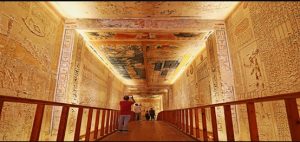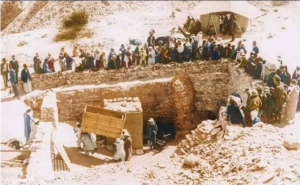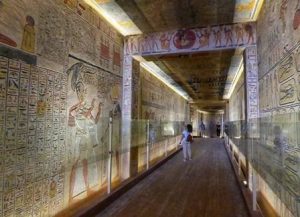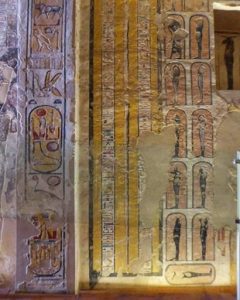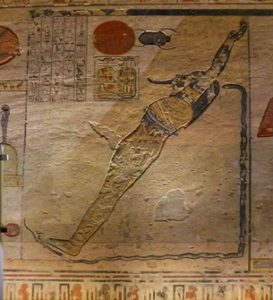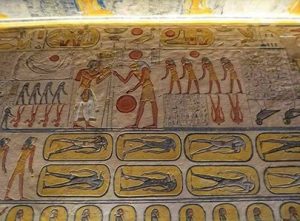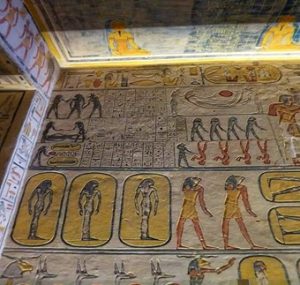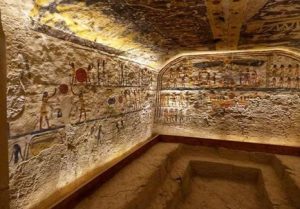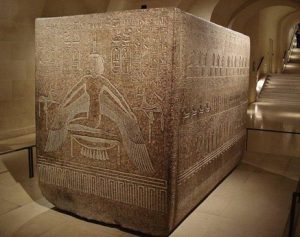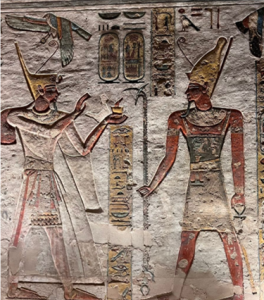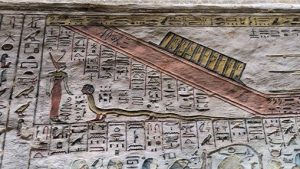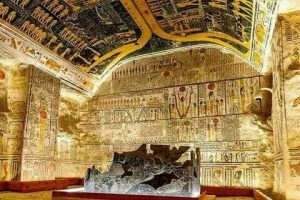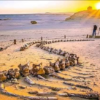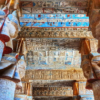The Valley of the Kings
Meaning of the word: The word “wadi” means a valley or a path between two mountains. As for the word “kings,” it’s because the kings of the New Kingdom were buried there.
Reason for choosing the location:
It was customary for ancient Egyptians to choose to build their tombs in a pyramidal shape. However, since all those pyramids were robbed, King Thutmose I decided to build his tomb in a dry valley that was not suitable for cultivation. He told his engineer, “Choose a tomb for me where there is no cultivation and no water.” By “no cultivation,” he meant it was not suitable for agriculture, and by “no water,” he meant it was not reached by floodwaters. His engineer chose this dry place, which is more than 25 kilometers away from the Nile River, so it would not be reached by the flood. And also, due to its dry nature, it would not be cultivated. The architect’s intelligence was evident in choosing this valley, which is parallel to Deir el-Bahri, which was used by the kings of the Middle Kingdom. We notice that the top of the mountain in the Valley of the Kings is shaped like a pyramid, so Thutmose I’s engineer considered it as if he were building a tomb inside a pyramid, as was customary for ancient Egyptians. Despite all these precautions, many thefts occurred at the end of the New Kingdom, as we learned from the papyri of Ramses IX. At the end of the New Kingdom and the beginning of the Late Period in the 21st Dynasty, the priest Panjem gathered all the mummies of the kings and placed them in two tombs. The first is inside the Valley of the Kings, which is the tomb of Amenhotep II. The second is the tomb of one of the priests near the temple of Queen Hatshepsut. The first to be buried in this place was King Thutmose I, the founder of the Egyptian Empire, the son of King Ahmose I. After him, all the kings of the New Kingdom were buried there, many of whom have been found, while others have not been found yet (as of 2024). There are more than 64 complete tombs in the valley. Some of them are not royal, such as the tomb of Yuya and Thuya (the parents of Queen Nefertiti, wife of Akhenaten). The most important royal tombs are those of the great kings Thutmose III, Amenhotep III, Ramses II, his father Seti I, and Ramses III. But the most famous of all is the tomb of the young Tutankhamun.
Picture for The Valley of the Kings
Important Discoveries in the Valley of the Kings
Since Champollion deciphered the hieroglyphs in 1822, there has been great interest in archaeological excavations in Egypt, especially in the 19th and 20th centuries. The Italian Belzoni discovered one of the most beautiful tombs in the Valley of the Kings in 1817, which is the tomb of Seti I (tomb number 17). (Interestingly, some people called it the Belzoni tomb after its discoverer.)
Tomb of Seti I
However, the most important discoveries of the 19th century were the discovery of the mummies of the kings. The first discovery was near Deir el-Bahri in 1871 in what was known as the Deir el-Bahri cache, which was discovered by the Egyptian Abd al-Rasul family and contained about 30 mummies of kings. The second discovery was inside the Valley of the Kings, known as the Valley of the Kings cache, which was discovered in 1898 by the Frenchman Victor Loret, when he discovered the tomb of Amenhotep II and found 12 mummies of kings inside, most importantly Amenhotep II, the owner of the tomb, Amenhotep III, Merneptah, Thutmose IV, and Ramses V. Inside it, boats were also found, reaching a length of two meters (the tomb is number 35).
The Tomb of Amenhotep II
As for the most important discoveries of the 20th century, it was the discovery of the tomb of Tutankhamun on November 4, 1922, by the British archaeologist Howard Carter, and fortunately, it was found intact and contained more than 5,000 artifacts, some of which were covered in gold, the most famous being the golden mask of Tutankhamun. (The tomb is number 62)
The moment of exhuming the belongings of Tutankhamun’s tomb, 1922
A Moment of Awe from Carter Upon discovering the treasures of Tutankhamun inside his tomb.
The most important tombs in the Valley of the Kings The Tomb of Ramses IX (Tomb Number 6)
King Ramses IX was the grandson of Ramses III. He was the eighth king of the Twentieth Dynasty. King Ramses IX ruled for approximately 18 years. He ruled from the capital of Ramses in the Delta, which allowed the priests of Amun to extend their control to Upper Egypt and end the New Kingdom era. The most notable feature of his reign was the widespread tomb robberies. A complaint was filed by the governor of Thebes to the king, accusing the governor of Thebes of robbing tombs. The king conducted an investigation, and the investigations proved that the governor of Western Thebes was involved in the tomb robberies. As a result, it was decided to hide the mummies of the kings and move them from their tombs to alternative tombs. The most important of these was the tomb of Amenhotep II, where the Deir el-Bahri cache was found in 1898. The tomb is distinguished by its wonderful scenes and colors, which it still preserves to this day. However, his mummy was transferred in the era of Panjem to a tomb near Deir el-Bahri, which was discovered in 1871 in what was known as the Deir el-Bahri cache (where his mummy was found along with the mummies of some great kings such as Thutmose III and Ramses II).
Description of the tomb:
The tomb consists of 3 corridors, then a four-pillared hall from which we reach the burial chamber:
The first corridor:
On the walls to the right of the entrance, there is a picture of the king burning incense and offering vessels to the god “Amun-Ra-Hor Akhty” and the goddess ” Meretseger,” the goddess of the dead in “Deir el-Medina” (the lover of silence). And on the opposite wall, we see the pharaoh performing the ritual known as offering the royal offering to the god “harmekhes” and the god “Osiris.” Then we see on the right nine snakes followed by nine demons with bull’s heads, and nine shapes, each placed in an oval shape, and nine images with the heads of jackals. These are the nine groups of creatures from the underworld, and it is a scene from the Book of the Underworld. And on the opposite wall, we see chapter 125 of the Book of the Dead (the chapter of negations). In it, the deceased is cleared of all the sins that were committed in the world, saying: I have not weighed falsely. I have not stolen. I have not lied. I have not transgressed against the boundaries of another. I have not polluted the waters of the Nile. I have not disobeyed my parents. I have not looked at my neighbor’s wife. And below this text is a picture of a priest dressed as the god Horus, pouring the signs of “life,” “stability,” and ” goodness ” on the pharaoh in a niche in front of Amun and one of the goddesses of the dead.
Scenes from the first corridor of the tomb
The second corridor:
On both sides, we see the snake guarding the door. The one on the left is said to guard the door for the one who dwells in the tomb. And the one on the right is said to guard the gate of Osiris. And on the left, we see the pharaoh advancing towards the tomb, and a goddess carrying his name stands in front of him, performing the function of a doorkeeper. After that, we find on the left an inscription from the Book of the Dead, and we see the king after it worshipping the god Khonsu, who is a god in the form of a man with a falcon’s head, who addresses the pharaoh saying: (I have given you my strength, my years, my throne, and my throne on earth to become a spirit in the underworld, and I give the names of your spirit and your body to the underworld eternally).
A scene from the second corridor
The third corridor:
On the left Zwall, we see the path of the sun during the second and beginning of the third hour of the night. And on the right wall, we see the pharaoh presenting the image of justice to the god Ptah, beside whom stands the goddess of justice (Maat). And near that is a picture of the resurrection, where we see the mummy of the king lying on a mountain with his arms raised above his head, and above that is a picture of a scarab and the sun disk rising. And since the sun renews the activity of the world every morning, the mummy of the king will also return to life again upon its resurrection. Then we see on this wall and opposite it three rows of demons, one above the other. In the top row, we see eight suns, in each of which a black man stands on his head. In the middle row, we see snakes pierced by arrows and women standing on hills and a scarab in a boat that ends with the heads of snakes at the front and rear. And in the bottom row, there are demons mixed with snakes, and four men bent backwards throwing scarabs from their mouths. And on the opposite side, we see a picture of a similar priest, holding a vessel of water that flows over the ram of Khnum, the god of the cataracts, from which it is believed that the sacred Nile water springs. And these two priests wear the traditional leopard skin. It seems that the meaning of these two is that they instill wisdom and purity in the king.
Ramses IX presents Maat to the god Ptah
Scenes of the Resurrected in the Afterlife
Scenes from the Third Corridor
A view of the god Khnum
Scenes from the Third Corridor
The Burial Chamber
Then we reach a hall supported by four pillars, from which we enter the burial chamber where we find a basin carved into the rock which once held a granite sarcophagus, but it is now lost. On the walls, we see gods and demons, and on the vaulted ceiling of the chamber, there are two images of the sky goddess Nut (representing morning and evening), and below that, groups of stars and boats. In the burial chamber, the image of the child Hor behind the aforementioned basin is striking. He is depicted sitting inside the winged solar disk.
The stairway leading to the burial chamber
The burial chamber in the tomb of Ramses IX
The Tomb of Ramses III (Tomb number 11):
He is considered the last of the great kings of the New Kingdom. His reign was marked by attacks from the peoples of the Mediterranean on Egypt. The king protected Egypt’s borders and fought them, uttering his famous words: “May the hand of anyone who harms Egypt be cut off.” Therefore, we find in his temple at Habu a famous scene where he sits on the throne and in front of him are scribes writing down what is presented to the king as the severed hands of enemies. He ruled for 32 years, and at the end of his reign, one of his wives tried to install her son Pentawer in place of King Ramses III (in what was known as the wives’ Conspiracy). But he discovered the conspiracy and killed his wife and son. It is believed that the screaming mummy belongs to his son Pentawer. The archaeologist James Bruce discovered the tomb in 1768 but did not reach the burial chamber. William Brown was the first to reach the burial chamber in 1792 and took the outer sarcophagus, which is now in the Louvre Museum in France.
Description of the tomb:
His father, Setnakht, began building the tomb, but he died before completing it and was buried in another tomb. Ramses III completed the construction of the tomb and was buried in it. The tomb consists of several corridors, 125 meters deep. The first corridor leads to two corridors, one of which ends in a sealed room and the other leads to a hall with four pillars, ending in two corridors that lead to the burial chamber.
Important scenes in the tomb
The burial sarcophagus of King Ramses III in the Louvre Museum, Paris



